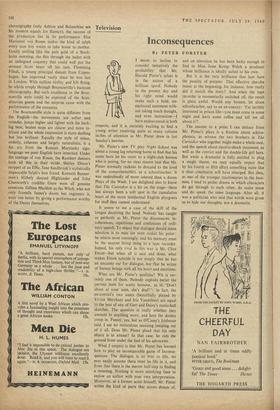Ballet
Flying Scott
By CLIVE BARNES
OVER the space of thirty years British ballet's founding mother, Marie Rambert, has done the State some considerable service. Last week her company crowned its third and started its fourth decade by producing what can be called the first of all modern ballets, La Sulphide. As befits its Romantic back- ground, the ballet is set in Sir Walter's Scotland. The hero James is preparing to marry a village girl, Effie, when he is inconveniently visited by a sylph. He follows her to the woods, where his efforts to give her mortality prove only too suc- cessful, and she loses both wings and life with dis- concerting promptitude Effie, understandably piqued by James's behaviour, marries his rival Gurn.
The Ballet Rambert production (which with surprising insensitivity has been rechristened T/w Sylph) is mounted from the Copenhagen version by the Swedish ballerina Elsa Marianne von Rosen and her husband, the Danish ballet historian Allan Fridericia. The result gives a fine idea of Bournonville's robust, inventive choreography and also conveys the sweet, linger- ing atmosphere of Romanticism and the essen- tial strain of gallantry that Schumann caught in describing Chopin's music as 'cannons buried in flowers.' The music by the Danish Lovenskjold is pale and uninteresting and it is not here helped by being thinly played--with one trumpet suc- cessfully trying to sound like the massed brass of Kneller Hall—or by the use of a live-minute overture better suited to curdle milk than to set the scene.
Apart from Bournonville's ever-remarkable choreography (only Ashton and Balanchine are his modern equals for fluency), the success of the production lies in its performance. Elsa Marianne von Rosen makes the kind of sylph every nice boy wants to take home to mother. Gently smiling like the pale gold of a Stock- holm morning, she flits through the ballet with an unfeigned coquetry that could well put the stoutest Scots heart off his oats. Flemming Flindt, a young principal dancer from Copen- hagen, has improved vastly since he was last in London. With stallion virility and kilt flying, he whirls crisply through Bournonville's buoyant choreography. But such excellence in the Bour- nonville style could be expected of the Scan- dinavian guests and the surprise came with the performance of the company.
The Bournonville style is quite different from the English—the movements are softer and rounder, jumps higher and lighter with the back- leg bent, beaten steps are clearer and more in- tricate and the whole impression is more dashing but less brilliant. Equally the style of mime, orderly, coherent and largely naturalistic, is a far cry. from the Russian Maryinsky sign- language we poor English have inherited. Under the tutelage of von Rosen, the Rambert dancers took all this in their stride. Shirley Dixon's moppet of an Effie, June Sandbrook's stylistically impeccable Sylph's best friend, Kenneth Banner- man's blithely danced Highlander and John Chesworth's credible Gurn were all genuine creations. Gillian Martlew as the Witch, who not only foretells James's doom but engineers it, went one better by giving a performance worthy of the Danes themselves.



































 Previous page
Previous page